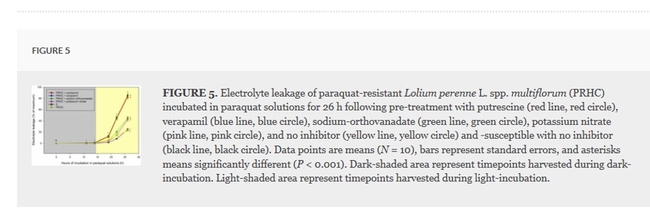In our post yesterday, we shared the results of some of Caio's field research on management of the multiple-resistant Italian ryegrass population from the Sacramento Valley. In addition to that applied-research, Caio has also been doing some really interesting basic-research trying to understand the biochemical mechanisms of resistance to paraquat in that population.
Toward that end, his first peer-reviewed scientific journal article on that research was published recently in the open-access journal Frontiers in Plant Science. If you'd like to take a look at some of the technical results, here's a link to the article "Vacuolar sequestration of paraquat is involved in the resistance mechanism in Lolium perenne L. spp. multiflorum"
Caio did several different experiments to dig into what was going on.
- First, he did a dose-response experiment in the greenhouse to compare the resistant and susceptible population's responses to a wide range of paraquat (really low to really high).
- Then, he used radio-labeled paraquat to look into how the herbicide was absorbed and whether it was metabolized differently in the R & S populations.
- The effects of the herbicide on the photosythetic processes was evaluated to determine if the R plants were injured by paraquat and then recovered or if they were not injured at all.
- Finally, he used a really cool technique to evaluate the effects of several membrane transport inhibitor on paraquat activity in leaf tissues. Basically, the herbicide has to cross several different membranes to get from outside the plant to the chloroplast where its site of action is. A series of inhibitors was used to block various "transporters" and then he looked at electrolyte leakage (paraquat disrupts membranes) to see if exposure to one of the inhibitors could reverse the resistance.
The evidence suggests that paraquat resistance in this ryegrass population is related to its ability to sequester the herbicide in the vacuole (a subcellular compartment that is used to store waste products, toxins, and other stuff the cell can't utilize).
Pretty interesting laboratory work that really helps inform what we see out in the field.
Take care,
Brad
Attached Images:
